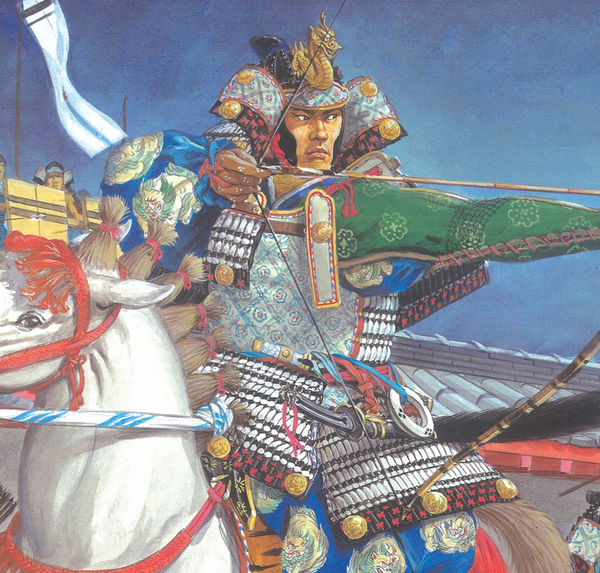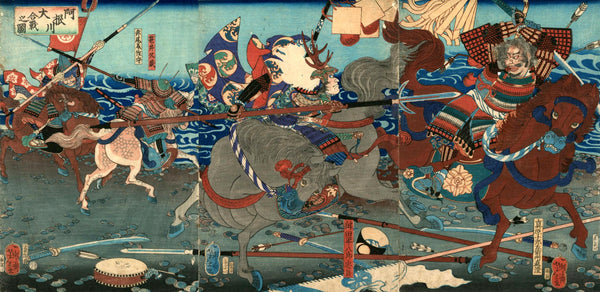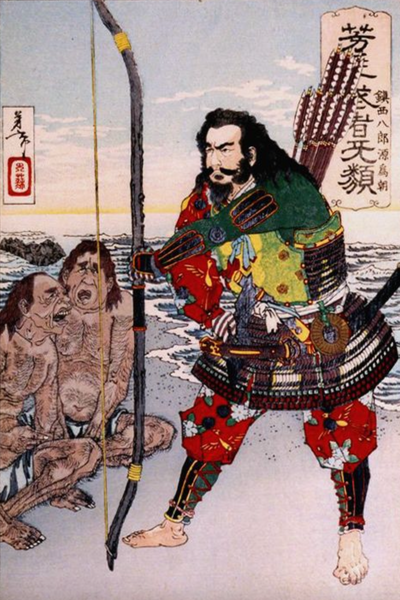Did Samurai Use Katanas?
Did Samurai Use Katanas?
Throughout history, the Samurai had to fulfill many military and bureaucratic roles, and each field required different weapons. So, did Samurai use katanas? Short answer is yes, but not as frequently as you might think. The Katana is the most recognized samurai weapon, courtesy of orientalism and mass media references, but that’s not their only or even major weapon.

The Samurai used conventional weapons for war, like the Tachi, Naginata, Uchigatana, Yumi, Kabutowari, Nagamaki, and many more. They trained in Bugei jūhappan, a collection of different martial arts that included a variety of weapon techniques.
Samurai have been around so long that nailing their exact nature is tricky. That is also true for both their battle styles and their armaments. A katana would quite literally be the last weapon a samurai will pull out for an actual battle. This article should give you a better idea of the weapons the Samurai used in different periods of history.
Table of Content
Emergence Of Samurai
The history of Samurai dates back hundreds of years, with their earliest roots in the military structure of pre-shogunate Japan. They started showing up around the early 700s during the Taika reform. But Samurai became an official position during and after the first shogunate era. The Kamakura shogunate solidified the Samurai as an official class in the administrative hierarchy of Japan.
Most people’s idea about a Samurai nowadays is almost entirely inaccurate. Contrary to popular media, Samurai were not some battle-crazed warrior types partaking in all kinds of badassery. They were, in fact, closer to bureaucrats in the strictest sense of the word, bureaucrats who just happened to be really good with the sword.
The samurai culture did not only revolve around bloodshed and the art of taking lives. In fact, showing one’s blade in public during the Edo period was a crime. Drawing the sword meant you had to be ready to forfeit your life.
The closest version of Samurai that most people are familiar with these days were the samurai of the Sengoku Period. That era was plagued with bloodshed of epic proportions, with war raging across the country.
Samurai Weapon of Different Eras
The definition of Samurai isn’t always constant throughout history. Their duties varied based on different timeframes and the political landscape of Japan. The only consistent element of a Samurai is the idea of loyalty. They were loyal to their Shogun, and they were loyal to their Daimyo- feudal lords. Even the Ronins had a skewed sense of loyalty towards themselves.
The types of weapons they used also varied and changed with time. Let’s look at Samurai from different historical periods:
1. Heian Period (Bows)
The Heian period was when art and culture flourished. It was an era heavily influenced by the Tang dynasty’s appreciation for the fine arts. In this era, Samurai were the armed retainers of the lords of the outer provinces.
The Samurai were masters of combat, they are proficient in archery, horseback archery, spearmanship, and swordsmanship skills, in war, they wear full samurai armor, shooting arrows in 1 on 1 duel. The country was relatively peaceful in the early Heian period they never had to use much of that expertise and lay dormant.

However, such peace wouldn’t last long, as the Heian period was heading toward political instability. Two significant things happened in the Heian period:
Establishment of the Shogunate
The Imperial aristocrats just gave up on ruling and eventually lost themselves in art and culture. They let the regional lords do their own thing- a terrible decision that would lead to the overthrowing of the aristocracy. The provincial lords would later establish a more militarized government.
There were two kinds of retainers during this time. The peace-loving, non-combatant retainers of the aristocracy. And the battle-ready retainers, or Bushi of the outer provinces. The lords of the outer regions used this period to overthrow the emperor using their superior military might.
The emperor essentially became the Shogun's puppet and lost all ability to control the situation because the Shogun was the one with the army.
The Mongol Invasion
In the late 13th century, Kubla Khan set his sights on Japan. By this point, Kubla Khan brought half the world to its knees and became the single unified conqueror. He invaded Japan twice, but natural disasters forced him back both times. But only after laying waste to the Tsushima and Iki islands.
The Mongols gained the upper hand during the first invasion. But the second time, the Samurai were more prepared. They made stone walls and outposts to curve the invading army’s momentum. In these battles, the Samurai mostly made use of their Archery skills.
Strictly in terms of mounted archery, the war-veteran Mongols were far superior to the Samurai. But the samurai were better with the longbow. They ravaged the Mongol ships and kept the army from gaining a proper foothold on the mainland. Stalling the invaders out until, ultimately, they were forced by a typhoon a second time.
In the melee, the Samurai mostly used spears and Uchigatana. The Mongol army mainly consisted of mounted cavalry, and it was easier to battle mounted enemies with spears due to their better reach.
2. Sengoku Period (Melee Weapons)
In the later part of the Ashikaga Shogunate, the selection of Imperial succession sparked the Onin War. It was known as the Sengoku Jidai or the warring states period of Japan. The era that created legends like Hattori Hanzo, Miyamoto Musashi, Oda Nobunaga, and Tokugawa Ieyasu.
The Sengoku Period was rife with conflict, backstabbing, and siege wars. It was a time when one-on-one duels didn’t mean much. As even minor conflicts lead to clan wars between prominent samurai clans. Hundreds and even thousands of participants fought in such battles, so single combat didn’t have much effect.
The weapons used by the samurai during this period are as follows:
Melee Weapons

Tachi is a curved sword like the Katana but more suited for horseback combat. The cavalry charge was prevalent during this time due to people like Takeda Shingen. So, Anti-cavalry weapons were necessary for every war.
The Nagamaki was a giant curved sword. These were primarily popular for dealing with cavalry units. The Nagamaki had a blade similar to an Uchigatana. But it had a significantly longer handle, making it about as long as a standard pole weapon. These came in curved and straight versions.
Odachi or Nodachi were also popular during this period due to similar reasons. Unlike the Nagamaki, Odachi had a smaller handle, but it's blade was longer.
The Yari was the primary weapon for most foot soldiers and Samurai. Yari is a spear with a straight pointy blade and a long pole. These were easy to make and use but were brutally effective at dealing with cavalry.
The Samurai also used blunt weapons like Kanabo. Kanabo is a variant of a spiked club, either made with a combination of heavy wood and iron plating or just pure iron. They are two-handed war clubs. Favored weapons of warriors with higher physical stats. Kojima Yataro, also known as “The Ogre,” was known to have used Kanabo.
The Samurai also carried a shorter version of the katana Wakizashi, and dragger called Tanto. Tanto was used that for committing Seppuku. For a Samurai, it was dishonorable to die at the hands of an enemy. So, many chose to take their own lives instead. Oda Nobunaga did the same when Akechi Mitsuhide’s men surrounded him.
Ranged Weapons

The Samurai had equal expertise in Archery as they did with Blades. Samurai had excellent archery skills, and they put that skill to good use during the Sengoku period.
Yumi has been the ranged weapon of choice for the Samurai for centuries and was also used during the Sengoku Period. However, Oda Nobunaga and many of his contemporaries also used firearms for their war strategies. The battle monks of Ishiyama Hongan-ji also used firearms and were one of the most formidable opponents of Oda Nobunaga.
Firearms were particularly popular as hidden weapons because they were easier to shoot. Oda Nobunaga used Tanegashima, a type of musket in large-scale military deployment. He was also one to take two shots from Hinawajau, another matchlock firearm, and survived due to his armor. Sugitani Zenjudo, a Koga clan assassin, landed the shots.

3. Edo Period (Uchigatana)
After Tokugawa Ieyasu unified Japan after the Sengoku Period, the country saw almost two centuries of peace and stability. In such a time of peace, the roles of the Samurai changed once more. The Samurai of the Edo period did not partake in bloodshed as often as the ones from the Sengoku period.

The Samurai of this period focused more on self-discipline than the art of killing. It’s where many of the non-combat martial arts practices flourished. The Daimyo of the Edo period gave their Samurai managerial and administrative duties.
During this period, the Samurai carried two swords as per Shogunate law. One was the Katana, and the other was a shorter Tanto. They did not draw their blades unless absolutely necessary. Aside from that, firearm technology started to improve.
Downfall Of The Samurai
In the Edo period, the Tokugawa Shogunate started a policy of isolation to resist destabilizing factors in the nation. That all ended in the 19th century when Commodore Matthew Perry sailed to Edo port with his fleet of battleships.
The US wanted Japan to open up their port for trade and threatened violence should their demand be rejected, a very American thing to do. The Tokugawa Shogunate accepted the terms because Japan did not have enough military might to go against a foreign military giant at the time, as it was going through a lot of internal unrest.
This period is marked by extensive political upheaval, the re-establishment of imperial power, and the radical modernization of Japan. Western firearms became immensely popular during this time. And it became the go-to weapon for both large and small conflicts. Eventually, the Meiji Restoration happened, and the Samurai lost their official status.
The end of the Katana era
The Sword Abolishment Edict (廃刀令) marked a pivotal moment in Japanese history, significantly altering the societal status of the samurai. Following this decree, only ex-lords, military personnel, and law enforcement officers were permitted to publicly carry and wield the katana. This regulation severely affected the samurai class, stripping them of their esteemed position and their cherished swords as the new government deemed their role in society obsolete.
This loss of status and the confiscation of their katanas ignited deep resentment among the samurai, culminating in the Satsuma Rebellion, also known as the Southwest War (Seinan War). In this conflict, the government forces, composed primarily of novices armed with firearms, faced formidable challenges against the Saigo Army. This army, made up of battle-hardened samurai adept in katana warfare, showcased the enduring effectiveness of the sword in close combat. Despite ultimately succumbing to the government forces, the samurai's prowess in battle underscored the katana's enduring tactical value. Recognizing this, the government continued to incorporate the katana and its techniques in the training of the army and police forces, ensuring its legacy in Japanese martial tradition.
Martial Arts Using Katana

Quite a few distinct sword styles originated from the katana. The Samurai were rigorous in their pursuit of sublimation in the path of the blade. And many chose to take up martial arts practice during the peaceful periods. Here are some modern iterations of Katana Martial Arts:
Kenjutsu
Kenjutsu is a school of katana martial arts that predates the Meiji restoration. It is probably the only classic Samurai swordsmanship that managed to survive to this day. But authentic Kenjutsu is still incredibly difficult to find.
Kenjutsu rose to fame after the Sengoku Jidai. The Edo period that followed the warring era had many battle-ready Samurai but no battles. So, many of them took to practicing martial arts and opening swordsmanship schools. The collective form of all offshoots of different Samurai katana styles consolidated as Kenjutsu.
Kendo
Kendo is a comprehensive Katana-based martial art developed during the Meiji restoration to give the existing Samurai a combative environment to practice their craft. The kendo kata are all focused on the simplified forms of actual combat movements.
In modern kendo, the places you get the most points for hitting an opponent are traditionally vital areas that swordsmen tend to strike during combat.
Iaido
Much like Kendo, Iaido is also a distilled version of numerous katana-based martial arts practiced by the Samurai. Iaido mainly focuses on the etiquette of handling a katana. Iaido also teaches discipline and self-reflection.
The first part of Iaido is the art of drawing the blade. Drawing a katana in one fluid motion and handling it without harming the sword or the wielder. The second part of Iaido is the art of targeting and cutting the target.
The third part of Iaido is cleaning the blood on the blade. And the final part of Iaido is placing the blade back into the Saya. Tameshigiri is an advanced version of Iaido. It’s where the practitioner can test their targeted cutting skills.
Toyama Ryu
Toyama Ryu is a late Meiji period martial art that was created during the time of modernization in Japan. It is a set of bayonet and katana skills for military purposes. The skills in this martial arts are lethal and practical for dispatching people.
Toyama Ryu is not an old-school martial art of Japan. The Japanese military developed it to incorporate katanas into modern combat.
Conclusion
Did Samurai use katanas? Yes, they did. It was akin to a Samurai’s soul. But they did everything they could to not use their primary Katana in actual combat because they had other options.
It was not the primary weapon for actual battles, as the Samurai were technically mounted archers more than anything. They used Larger Curved swords like Uchigatakana, Nodachi, spears, and bows for actual combat.





















